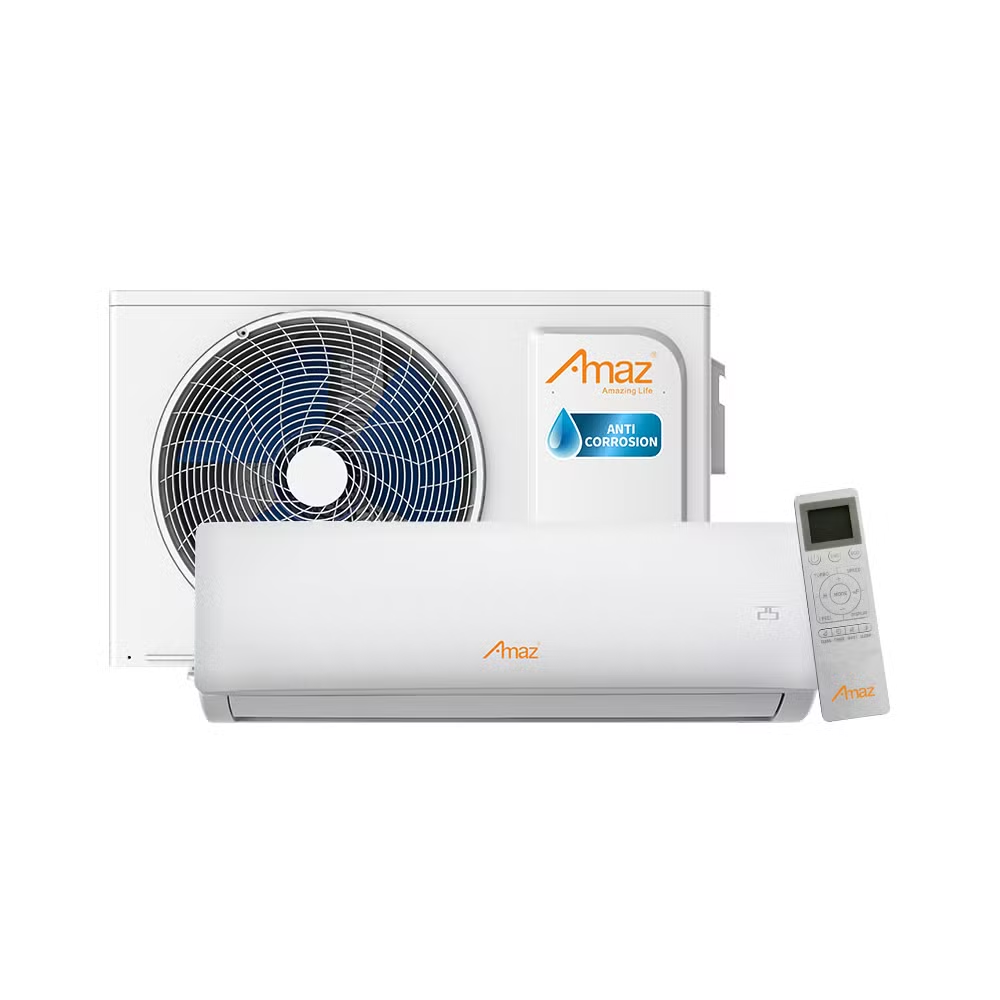A 3 ton ac unit refers to its cooling capacity, not its weight. In HVAC terms, 1 ton = 12,000 BTU/hour of heat removal. Thus a 3-ton unit is rated to cool 36,000 BTU/h of thermal load.
This capacity class is widely used in homes, small offices, and medium commercial spaces. Its effectiveness depends on matching building load, climate, ductwork design, and efficiency.
1. Cooling Capacity & Technical Basics
1.1 BTU, Tons, and Real-World Output
-
Definition: 1 ton = 12,000 BTU/h, so 3 tons = 36,000 BTU/h capacity.
-
Nominal vs. actual: The nameplate “36,000 BTU/h” is under ideal test conditions. Real output may be lower under high ambient conditions or duct losses.
-
Efficiency effects: Higher efficiency units maintain output more consistently across temperature extremes.
1.2 Typical Performance Metrics
| Metric | Typical Range / Value |
|---|---|
| SEER2 (Seasonal Efficiency) | 14 to 21 (or more in premium models) |
| EER2 (Fixed Efficiency) | 10 to 13 or higher |
| Sound Level (outdoor) | 60–75 dB |
| Line Set Max Length | 25 to 50 ft (varies by manufacturer) |
| Refrigerants | R-410A, R-32 in modern models |
For example, the Carrier site states that many 3-ton units today range from 14 to 21 SEER2 in their lineups.
A real example: the Goodman 3-ton condenser model GLXS4BA3610 has 36000 BTUh, uses R-32, and features a 15.2 SEER2 rating.
Thus, when shopping, compare the efficiency, not just the tonnage.
2. How Much Space Can 3 Ton AC Unit Cool?
2.1 Rule-of-Thumb Estimates & Their Limitations
Common heuristic: 3 tons cool ~1,500 to 2,000 sq ft of conditioned space under average insulation and moderate climate. The Carrier product page uses that range.
Some sources widen it: Logan’s blog suggests 1,200 to 1,500 sq ft for typical settings (though that is conservative).
However, a “square foot to ton” rule ignores many critical factors.
2.2 Key Variables That Change Coverage
-
Climate zone: hotter or sunnier zones increase load.
-
Insulation & envelope: well-insulated, tight homes reduce load; leaky ones increase it.
-
Ceiling height: 10 ft ceilings add more volume.
-
Window area and orientation: large west/south glass increases heat gain.
-
Duct losses: poor ducts reduce delivered cooling.
-
Internal gains: occupants, appliances, lighting all add heat.
2.3 Realistic Sizing Table
Below is a sample guideline table (approximate) for 3-ton coverage by climate zone and building quality:
| Climate Zone / Condition | Good Envelope | Average Home | Leaky / Poor Insulation |
|---|---|---|---|
| Mild (coastal, moderate) | 2,000–2,400 sq ft | 1,800–2,000 sq ft | 1,500–1,800 sq ft |
| Hot-humid (desert / deep south) | 1,800–2,100 sq ft | 1,500–1,900 sq ft | 1,300–1,600 sq ft |
| Mixed climate | 1,900–2,200 sq ft | 1,600–1,900 sq ft | 1,400–1,700 sq ft |
These numbers are estimates; always confirm with a load calculation.
3. Types, Features & Matching Components
3.1 System Types: Split, Packaged, Multi-stage
-
Split system: outdoor condenser + indoor evaporator coil. Most common in homes.
-
Packaged unit: all components in one outdoor box. Used in rooftop or constrained spaces.
-
Multi-stage / variable speed units: can run at partial capacity (e.g., 25% to 100%). Provide better efficiency, quieter operation, humidity control.
3.2 Matching Indoor Coil, Air Handler & Condenser
You cannot arbitrarily combine parts from different tonnages. The evaporator coil and air handler must match the 3-ton condenser in terms of capacity, airflow (CFM), and pressure drop. Mismatched pairings cause poor performance or void warranties.
3.3 Refrigerant Options & Modern Trends
-
Older models use R-410A refrigerant.
-
Newer designs adopt R-32 (lower global warming potential, better thermodynamics) as seen in some Goodman 3-ton units.
-
Future regulatory changes may phase down older refrigerants; buying a more modern refrigerant type helps longevity.
3.4 Efficiency & Comfort Features
When choosing a 3-ton model, consider:
-
SEER2/EER2 ratings
-
Compressor type: single-stage, two-stage, or variable-speed
-
Noise parameters: decibel levels (especially for outdoor placement)
-
Smart/connected controls: thermostat compatibility, WiFi, etc.
-
Warranty coverage: parts, compressor, labor
Higher efficiency models cost more but save energy and may qualify for rebates.
4. Cost, Economics & Payback
4.1 Typical Price Ranges
The cost of a new 3-ton AC unit including full installation often ranges from USD 3,000 to USD 15,000, depending heavily on region, brand, ductwork work, electrical upgrades, and system complexity.
Basic, non-premium models with minimal ductwork modifications often fall toward the lower end of the range. Highly efficient or multi-stage units with extensive duct retrofit push toward the upper range.
4.2 Operating Cost & Savings
Higher SEER2 units reduce electricity consumption. Over a 10–15 year life, energy savings can offset premium cost.
Simple formula:
Annual cost = (Cooling load BTUs ÷ 12,000) × Hours × (1 / SEER) × Electricity rate
If usage is 1,500 hours/year, at electricity cost of $0.15/kWh, a higher SEER2 unit may save hundreds annually over a lower-efficiency one.
4.3 Incentives & Rebates
Many utilities, states, or federal programs offer rebates or tax credits for high-efficiency HVAC systems. Check local programs. Manufacturers often promote incentives for high-SEER2 models. (Carrier product page mentions efficiency tiers)
4.4 Payback Example
If a premium 3-ton model costs $2,500 more than a base unit but saves $250/year in electricity, payback period = 10 years. After that, savings are pure benefit.
5. Installation: Best Practices & Steps
Installing a 3-ton AC unit is complex and should be done by qualified professionals. Below is a structured step sequence, with critical checks.
5.1 Pre installation Planning
-
Perform a Manual J load calculation to confirm 3-ton is appropriate
-
Assess existing ductwork; plan repairs or resizing
-
Acquire necessary permits; ensure compliance with local codes
-
Determine optimal condenser location (clearance, airflow, shade)
-
Confirm electrical supply (dedicated circuit, proper voltage & amperage)
5.2 Installation Steps (Sequence)
-
Mount Indoor Evaporator / Coil
-
Set the Outdoor Condenser on pad or bracket
-
Connect refrigerant lines / piping
-
Make electrical connections (line voltage + low-voltage controls)
-
Evacuate air & moisture (deep vacuum, ~500 microns)
-
Charge refrigerant per manufacturer specs
-
Test the system: airflow, pressures, thermostat, function
-
Final inspection & balancing
A good step-by-step R-32 3-ton installation guide is published by The Furnace Outlet.
5.3 Key Technical Checks & Calibration
-
Verify liquid/gas line diameters are correct
-
Ensure filter drier installed in liquid line (common in 3-ton guidelines)
-
Use dip switch settings, charging charts, and measured liquid line temperature to compute proper refrigerant pressures. The American Standard guide shows example for 3-ton systems.
-
Check static pressure in ducts; adjust blower or dampers.
-
Confirm airflow (CFM) is correct for capacity (typically ~400 CFM per ton = ~1,200 CFM for 3 tons)
5.4 Common Mistakes to Avoid
-
Skipping vacuum or insufficient vacuum leads to air/moisture contamination
-
Overcharging refrigerant causes inefficiency or damage
-
Incorrect line sizes or long runs reduce capacity
-
Poor duct sealing causes massive efficiency loss
-
Mismatched coil and condenser
Mike’s hands-on walkthrough for a 3-ton Goodman horizontal system illustrates many of these pitfalls.
6. Maintenance, Performance & Longevity
6.1 Regular Maintenance Tasks
-
Replace or clean filters every 1–3 months
-
Clean outdoor coil and keep debris clear
-
Check refrigerant charge and pressures annually
-
Inspect electrical connections and contacts
-
Clean drain line and pan to avoid water backup
-
Verify thermostat calibration and operation
6.2 Performance Monitoring
-
Track energy consumption over seasons
-
Monitor airflow and temperature splits (difference between supply and return)
-
Listen for unusual noise, compressor cycling or vibration
6.3 Life Expectancy & Reliability
A quality 3-ton system installed correctly can last 15–20 years or more. Components such as compressor, fan motor, capacitor often fail first.
7. Frequently Asked Questions (FAQs)
Q1: Will a 3-ton unit always run efficiently in cooler months?
A: Not necessarily. In colder ambient conditions, the unit runs less frequently or may not reach full capacity. Partial load operation demands good modulating design and proper efficiency ratings.
Q2: Can I retrofit a 3-ton system into my existing ducts?
A: Yes, if ducts are sized correctly and leakage is minimal. Improper ductwork can severely degrade performance.
Q3: What’s better: 3-ton single-stage vs. variable-speed?
A: Variable-speed offers better comfort, humidity control, quieter operation, and efficiency at partial loads. Single-stage is simpler and less costly upfront.
Q4: Can I mix appliances, lighting, and occupancy heat loads into the 3-ton calculation?
A: Yes. A proper load calculation (Manual J) includes internal gains from appliances, occupants, lighting, solar gain, and infiltration.
Q5: Is 3 tons enough for a two-story house with 3,000 sq ft?
A: Typically no. That size often demands 4 to 5-ton systems or multi-zone split systems, especially in hot climates.
8. Pros & Cons / Checklist
8.1 Advantages and Disadvantages of a 3-Ton AC
Advantages
-
Good match for many medium to large homes
-
Established product class with many options
-
Balanced performance vs cost
-
Many models support variable-speed for better control
Disadvantages
-
Can be inefficient if oversized or undersized
-
Requires well-designed duct system
-
Premium models cost significantly more
-
Refrigerant transition may complicate older equipment
8.2 Installation & Purchase Checklist (Before You Buy)
-
Use a certified technician to run load calculation
-
Confirm refrigerant type (R-32 vs older)
-
Match indoor coil / air handler to condenser
-
Review SEER2 and EER2 ratings
-
Check warranty periods and registration requirements
-
Assess duct system condition (leaks, sizing)
-
Evaluate electrical supply capacity
-
Ask for multiple quotes including labor, permits
-
Confirm installation steps (vacuuming, balancing)
-
Plan for annual maintenance
Learn More: CV Joint Replacement Cost: In-Depth Guide (2025)
Gyms With Childcare Near Me: The Definitive 2025 Guide for Parents
9. Conclusion
A 3 ton ac unit delivers approximately 36,000 BTU/h of cooling. It is suitable for many homes when properly matched to load factors such as insulation, climate, ceiling height, solar gain, and duct quality.
Selecting the right 3-ton unit means examining efficiency (SEER2/EER2), compressor type, noise, refrigerant, and matched components. Installation quality is critical: vacuuming, charge calibration, duct balance, and proper wiring all influence final performance.

